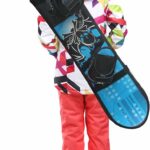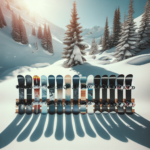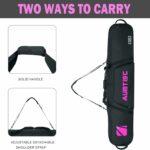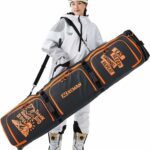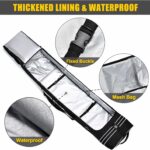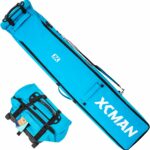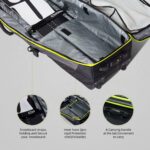Before heading off to your much-anticipated snowboarding trip, one of the essential decisions you’ll need to make is choosing the right snowboard. But with a mind-boggling array of shapes, sizes, styles, and brands out there, making that choice can be overwhelming. The following article “What Snowboard To Choose?” is going to guide you through this process. It will detail everything you need to understand about different snowboard types, the ideal snowboard length and width for your body structure, and what suits your riding style the best. It might seem ponderous, but trust us, getting the right gear can mark the difference between grumbling regret and thrilled exhilaration on the mountains.
Understanding Your Riding Style
Before heading out to choose a perfect snowboard, it is crucial to understand your riding style first. Your preferred terrain, skill level, speed, and turn style are all factors that will influence your choice.
Identifying your preferred terrain
What kind of terrain do you envision yourself riding on the most? Are you excited by the thought of carving down the groomers or do you prefer going for the off-piste adventures? Identifying your preferred terrain is an essential step that will guide you in your snowboard selection process.
Recognizing your skill level
It’s important to be honest about your skill level. If you’re a beginner, you will want to choose a snowboard that is forgiving and easy to control. More advanced riders might go for a responsive board that can handle high-speed turns or negotiate steep terrain.
Observing your speed and turn style
Pay close attention to your speed and turn style. Do you prefer fast, aggressive runs straight down the mountain, or taking slow, precise turns? This insight will be instrumental in deciding the kind of board you need.
Understanding Snowboard Types
There is a variety of snowboard types, each designed for specific riding styles and conditions.
Freestyle Snowboards
Freestyle snowboards are generally shorter, lighter, and more flexible, making them ideal for grab tricks, jumps, and jibbing. They come with a twin shape making them suitable for riding both forwards and backwards.
Freeride Snowboards
Freeride snowboards are for off-piste explorers and mountain lovers who prioritize speed and challenging terrains. A bit stiffer and longer than freestyle boards, they provide superior control in powder and uneven terrain.
All-Mountain Snowboards
All-mountain snowboards are the jack of all trades, designed to handle any terrain or snow conditions. They can carve on groomers, dart through trees or float in powder, making them a good choice for riders who crave variety.
Powder Snowboards
Powder boards are made for deep snow. They are longer in length for increased floatation on the snow surface. These boards have a serious setback stance and a wider nose to further improve float and speed.
Splitboards
Splitboards are a must-have for backcountry riders. They can be split into skis for climbing up slopes and rejoined as a snowboard for the descent, giving the freedom to access untouched snow.
Snowboard Size Selection
Deciding on the correct snowboard size revolves around your weight, height, and the type of riding you plan to do. The right combination of these factors will ensure the best control and stability while snowboarding.
Determining the right length
The length of a snowboard is primarily determined by your weight. A traditional method to estimate this is to choose a board that reaches somewhere between your chin and nose when stood on end. But remember, this is not an exact science. A shorter board may be more maneuverable, but a longer board will give you greater stability.
Analyzing the right width
When it comes to width, the key point is to avoid toe and heel overhang. Your snowboard’s width should be enough that your boots go just over the edges, but not too much to lead to uncomfortable and hard turning.
Understanding the effect of your weight on sizing
Your weight significantly affects the flex and control of your board. Heavier riders put more pressure on the board, causing it to flex more. If you’re on the heavier side, go for a longer and/or stiffer board and vice versa.
Choosing the Right Snowboard Shape
Snowboard shapes matter and play a vital role in how the board performs in different terrains.
Identifying directional shapes
Directional boards are designed to be ridden mainly in one direction. They usually have a pointed nose, a shorter tail, and the flex and bindings are set towards the back. They are great for speed and are generally used for all-mountain and freeride snowboarding.
Understanding true twin shapes
True twin boards are perfectly symmetrical with identical nose and tails. This shape is popular among freestyle riders who want the ability to ride in either direction.
Looking at directional twin shapes
A mash-up between directional and true twin boards, directional twins are versatile boards. They have a symmetrical flex but the bindings and other elements are slightly set back.
Contemplating Camber and Rocker
Understanding camber and rocker designs is key in comprehending how a board will perform.
Understanding camber
Camber is a slight upward curve in the middle of the board, with the contact points close to the ends. This offers riders more control, edge hold, and pop.
Getting the point of rocker
Rocker, or reverse camber, looks like a banana underfoot – raised in the middle while touching near the nose and tail. This gives the board a loose feel and helps the board float in powder.
Analyzing hybrid camber/rocker
Many modern snowboards feature a combo of camber and rocker, taking advantage of both worlds. This generally includes a variety of camber underfoot and rocker at either end.
Controlling Edge Technology
Advancements in edge technology have provided better hold and control over the board in various snow conditions.
Discovering Magne-Traction
Magne-Traction technology is akin to having a serrated knife beneath your feet. It’s all about extra contact points along the edge which work incredibly well on icy or hard-packed conditions.
Deciphering edge tech
Other edge technologies also enhance the grip of the snowboard. Some brands have proprietary edge tech geared towards improved control and stability.
Recognizing the advantages of frostbite edges
Frostbite edges extend out slightly beneath your bindings for terrific edge-hold on hard, icy conditions. These are invaluable for maintaining control in hard-pack and icy conditions.
Materials and Construction
The materials and how a snowboard is constructed will greatly impact how the board feels and reacts to your movements.
Understanding core materials
The core of a snowboard is usually made of wood or foam, or a combination of both. This makes the board lightweight yet durable, providing good flex and stability.
Considering the top sheet and base materials
Top sheets are mostly for aesthetics but good quality ones can help protect the core. Meanwhile, base materials (typically made from Polyethylene) come in two types: extruded and sintered. Extruded bases are slower but easy to repair while sintered bases are faster.
Contemplating the effect of sidecut and flex
The radius of a board’s sidecut affects its turn radius: a smaller sidecut leads to tighter turns. Flex, on the other hand, refers to the board’s stiffness. A softer flex is good for beginners while an advanced rider might prefer a stiffer board.
Snowboard Bindings
Bindings connect your boots to your board. They come in various types, sizes, and flexes.
Recognizing binding types
The two main types of snowboard bindings are strap-in and step-in. Strap-in bindings are most common and they provide a secured foothold. Step-in bindings are easier to get in and out of.
Determining the right binding size
Your binding size should match your boot size. Too big, and your boots might wobble; too small and you’ll find it hard to strap in.
Decoding binding flex
The flexibility of your binding should correlate with your riding style. A stiffer binding translates to more responsive and precise control, perfect for free-riders or all-mountain riders.
Snowboard Boots
No matter how good your board is, it can’t perform without the right pair of boots.
Perceiving the importance of properly fitting boots
Snowboard boots should be snug, comfortable, and keep your feet warm. Poorly fitting boots can ruin your day with discomfort and cold feet.
Comparing boot flex and features
Boot flex should complement your riding style: softer flex for beginners or park riders, stiffer flex for freeriding. Other features to consider are lacing systems, liners, footbeds, and cuffs.
Analyzing lacing systems
Traditional laces, speed lacing, and boa (dial system) are the three main types of lacing systems. Traditional is the most customisable but the most time-consuming. Speed laces and Boa are fast and easy, but less adjustable.
Brand and Pricing
Last but not least, brand and pricing matter. It’s not about boasting brand names, but about quality and after-sales service.
Studying the various snowboard brands
Each brand has its unique characteristics and features. Researching each brand will help you understand which one can best meet your snowboarding needs.
Weighing your budget
Let’s face it, snowboarding can be an expensive sport. You need to consider your money investment. But remember, you do get what you pay for in terms of quality and durability.
Contemplating price versus quality and features
There’s a balance between price, quality, and features. A cheap board has its limitations. It might not last as long and may not perform as you progress. Therefore, ensure that your chosen board provides the best mix of price, quality, and the features you need.
Choosing a snowboard can seem like an uphill task, but armed with a little knowledge, you’ll be well-equipped to make the right choice. After all, it’s about ensuring you have the combination of equipment that lets you enjoy those perfect snowy days to the fullest. Happy snowboarding!
- What Snowboard Bindings Should I Get? - January 23, 2024
- What Size Screws For Snowboard Bindings? - January 23, 2024
- How To Snowmobile On Water? - January 23, 2024

